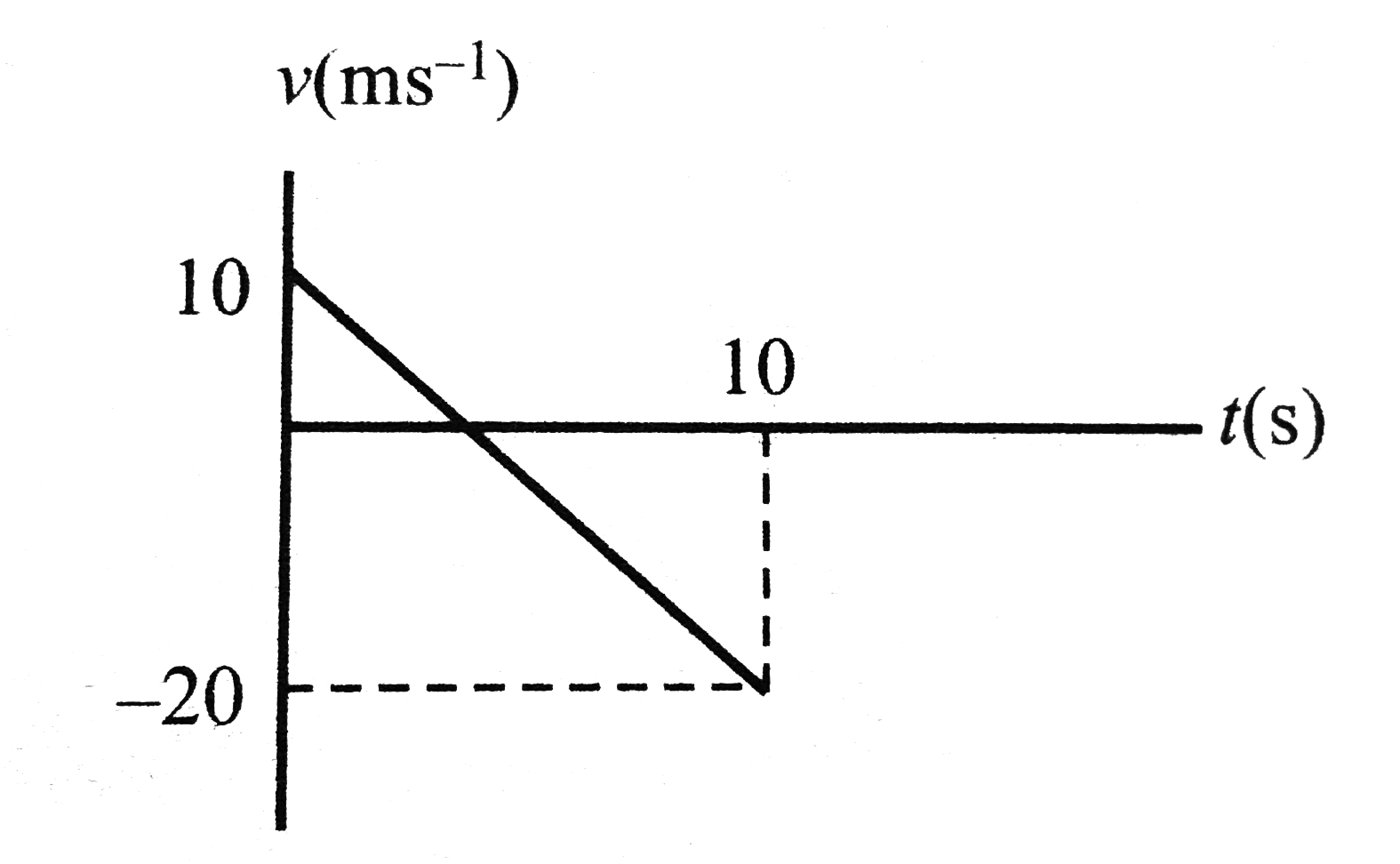The position of a particle moving on a stringht line under rthe action of a force is given as x=50t−5t2 Here, x is in metre and t is in second. If mass of the particle is 2 kg, the work done by the force acting on the particle in first 5 s is.
2500 J
−2500J
5000 J
−5000J
The correct Answer is:B
To solve the problem step by step, we will follow these steps:
Step 1: Determine the position function
The position of the particle is given by the equation:
x=50t−5t2
where x is in meters and t is in seconds.
Step 2: Calculate the velocity
The velocity v of the particle is the derivative of the position x with respect to time t:
v=dxdt=ddt(50t−5t2)
Calculating this derivative:
v=50−10t
Step 3: Calculate the acceleration
The acceleration a of the particle is the derivative of the velocity v with respect to time t:
a=dvdt=ddt(50−10t)
Calculating this derivative:
a=−10m/s2
Step 4: Calculate the force acting on the particle
Using Newton's second law, the force F acting on the particle can be calculated as:
F=ma
Given that the mass m=2kg and a=−10m/s2:
F=2×(−10)=−20N
Step 5: Calculate the work done by the force
The work done W by the force over a time interval can be calculated using the formula:
W=∫Fdx
We can express this in terms of time as:
W=∫F⋅vdt
Substituting the values of F and v:
W=∫50(−20)(50−10t)dt
Step 6: Evaluate the integral
Now we will evaluate the integral:
W=−20∫50(50−10t)dt
Calculating the integral:
W=−20(50t−5t2)50
Evaluating at the limits:
W=−20((50×5−5×52)−(50×0−5×02))
W=−20(250−125)
W=−20×125=−2500J
Final Answer
The work done by the force acting on the particle in the first 5 seconds is:
W=−2500J
---
The position of the particle is given by the equation:
x=50t−5t2
where x is in meters and t is in seconds.
The velocity v of the particle is the derivative of the position x with respect to time t:
v=dxdt=ddt(50t−5t2)
Calculating this derivative:
v=50−10t
The acceleration a of the particle is the derivative of the velocity v with respect to time t:
a=dvdt=ddt(50−10t)
Calculating this derivative:
a=−10m/s2
Using Newton's second law, the force F acting on the particle can be calculated as:
F=ma
Given that the mass m=2kg and a=−10m/s2:
F=2×(−10)=−20N
The work done W by the force over a time interval can be calculated using the formula:
W=∫Fdx
We can express this in terms of time as:
W=∫F⋅vdt
Substituting the values of F and v:
W=∫50(−20)(50−10t)dt
Now we will evaluate the integral:
W=−20∫50(50−10t)dt
Calculating the integral:
W=−20(50t−5t2)50
Evaluating at the limits:
W=−20((50×5−5×52)−(50×0−5×02))
W=−20(250−125)
W=−20×125=−2500J
The work done by the force acting on the particle in the first 5 seconds is:
W=−2500J
Topper's Solved these Questions
- WORK, ENERGY AND POWERBOOK - AAKASH INSTITUTE ENGLISHCHAPTER - WORK, ENERGY AND POWEREXERCISE - SECTION-C (OBJECTIVE TYPE QUESTIONS) (MORE THAN ONE OPTIONS ARE CORRECT)
16 Videos
- WORK, ENERGY AND POWERBOOK - AAKASH INSTITUTE ENGLISHCHAPTER - WORK, ENERGY AND POWEREXERCISE - SECTION-D (LINKED COMPREHENSION TYPE QUESTIONS) (COMPREHENSION-I)
3 Videos
- WORK, ENERGY AND POWERBOOK - AAKASH INSTITUTE ENGLISHCHAPTER - WORK, ENERGY AND POWEREXERCISE - SECTION-A (OBJECTIVE TYPE QUESTIONS (ONE OPTIONISCORRECT)
60 Videos
- WAVESBOOK - AAKASH INSTITUTE ENGLISHCHAPTER - WAVESEXERCISE - ASSIGNMENT ( SECTION-D ( Assertion - Reason Type Questions ))
12 Videos
Similar Questions
Force acting on a particle is given by F=A−xBt, where x is in metre and t is in seconds. The dimensions of B is -
View SolutionThe displacement of a particle moving in a straight line is described by the relation s=6+12t−2t2. Here s is in metre and t in second. The distance covered by the particle in first 5s is
View Solution
Knowledge Check
A particle moves in x-y plane according to the equations x=4t2+5t+16andy=5t where x, y are in metre and t is in second. The acceleration of the particle is
A8ms−2B12ms−2C14ms−2D16ms−2
The displacement of a particle moving in a straight line is described by the relation s=6+12t−2t2. Here s is in metre and t in second. The distance covered by the particle in first 5s is
View SolutionThe position of a particle is given by
x=2(t−t2)
where t is expressed in seconds and x is in metre.
The particle
View SolutionThe velocity-time graph of a particle moving in a straight line is shown in figure. The mass of the particle is 2kg. Work done by all the forces acting on the particle in time interval between t=0 to t=10s is

View SolutionThe motion of a particle along a straight line is described by the function x=(2t−3)2, where x is in metres and t is in seconds. Find
(a) the position, velocity and acceleration at t=2s.
(b) the velocity of the particle at origin.
View SolutionThe motion of a particle along a straight line is described by the function x=(2t−3)2, where x is in metres and t is in seconds. Find
(a) the position, velocity and acceleration at t=2s.
(b) the velocity of the particle at origin.
View SolutionThe distance x moved by a body of mass 0.5 kg under the action of a force varies with time t as
x(m)=3t2+4t+5
Here, t is expressed in second. What is the work done by the force in first 2 seconds?
View SolutionThe position of a particle is given by
x=2(t−t2)
where t is expressed in seconds and x is in metre.
The acceleration of the particle is
View Solution
